Chunshi Wang
Hunyuan3D Studio: End-to-End AI Pipeline for Game-Ready 3D Asset Generation
Sep 16, 2025



Abstract:The creation of high-quality 3D assets, a cornerstone of modern game development, has long been characterized by labor-intensive and specialized workflows. This paper presents Hunyuan3D Studio, an end-to-end AI-powered content creation platform designed to revolutionize the game production pipeline by automating and streamlining the generation of game-ready 3D assets. At its core, Hunyuan3D Studio integrates a suite of advanced neural modules (such as Part-level 3D Generation, Polygon Generation, Semantic UV, etc.) into a cohesive and user-friendly system. This unified framework allows for the rapid transformation of a single concept image or textual description into a fully-realized, production-quality 3D model complete with optimized geometry and high-fidelity PBR textures. We demonstrate that assets generated by Hunyuan3D Studio are not only visually compelling but also adhere to the stringent technical requirements of contemporary game engines, significantly reducing iteration time and lowering the barrier to entry for 3D content creation. By providing a seamless bridge from creative intent to technical asset, Hunyuan3D Studio represents a significant leap forward for AI-assisted workflows in game development and interactive media.
X-Part: high fidelity and structure coherent shape decomposition
Sep 10, 2025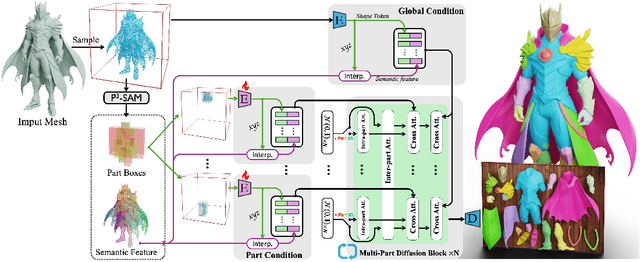
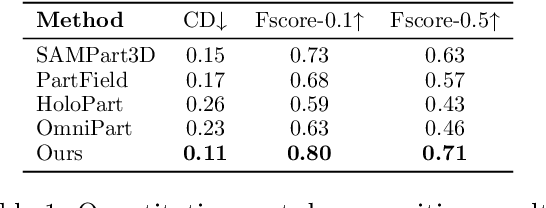
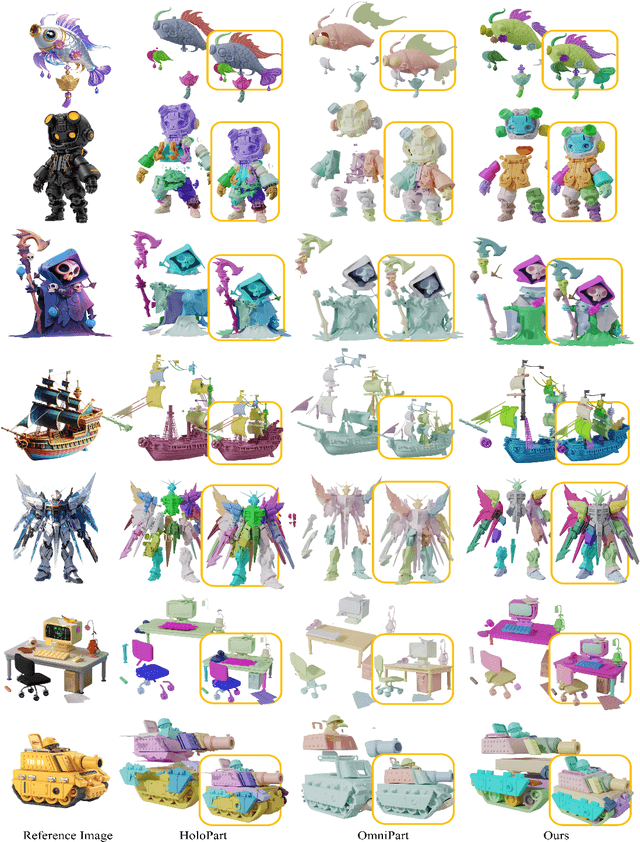
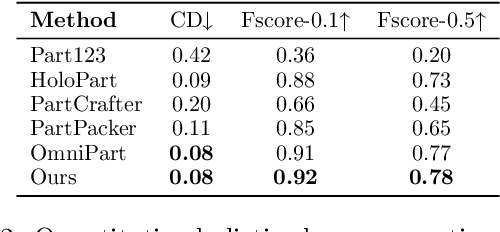
Abstract:Generating 3D shapes at part level is pivotal for downstream applications such as mesh retopology, UV mapping, and 3D printing. However, existing part-based generation methods often lack sufficient controllability and suffer from poor semantically meaningful decomposition. To this end, we introduce X-Part, a controllable generative model designed to decompose a holistic 3D object into semantically meaningful and structurally coherent parts with high geometric fidelity. X-Part exploits the bounding box as prompts for the part generation and injects point-wise semantic features for meaningful decomposition. Furthermore, we design an editable pipeline for interactive part generation. Extensive experimental results show that X-Part achieves state-of-the-art performance in part-level shape generation. This work establishes a new paradigm for creating production-ready, editable, and structurally sound 3D assets. Codes will be released for public research.
SCANet: Split Coordinate Attention Network for Building Footprint Extraction
Jul 28, 2025Abstract:Building footprint extraction holds immense significance in remote sensing image analysis and has great value in urban planning, land use, environmental protection and disaster assessment. Despite the progress made by conventional and deep learning approaches in this field, they continue to encounter significant challenges. This paper introduces a novel plug-and-play attention module, Split Coordinate Attention (SCA), which ingeniously captures spatially remote interactions by employing two spatial range of pooling kernels, strategically encoding each channel along x and y planes, and separately performs a series of split operations for each feature group, thus enabling more efficient semantic feature extraction. By inserting into a 2D CNN to form an effective SCANet, our SCANet outperforms recent SOTA methods on the public Wuhan University (WHU) Building Dataset and Massachusetts Building Dataset in terms of various metrics. Particularly SCANet achieves the best IoU, 91.61% and 75.49% for the two datasets. Our code is available at https://github.com/AiEson/SCANet
ParticleGS: Particle-Based Dynamics Modeling of 3D Gaussians for Prior-free Motion Extrapolation
May 26, 2025Abstract:This paper aims to model the dynamics of 3D Gaussians from visual observations to support temporal extrapolation. Existing dynamic 3D reconstruction methods often struggle to effectively learn underlying dynamics or rely heavily on manually defined physical priors, which limits their extrapolation capabilities. To address this issue, we propose a novel dynamic 3D Gaussian Splatting prior-free motion extrapolation framework based on particle dynamics systems. The core advantage of our method lies in its ability to learn differential equations that describe the dynamics of 3D Gaussians, and follow them during future frame extrapolation. Instead of simply fitting to the observed visual frame sequence, we aim to more effectively model the gaussian particle dynamics system. To this end, we introduce a dynamics latent state vector into the standard Gaussian kernel and design a dynamics latent space encoder to extract initial state. Subsequently, we introduce a Neural ODEs-based dynamics module that models the temporal evolution of Gaussian in dynamics latent space. Finally, a Gaussian kernel space decoder is used to decode latent state at the specific time step into the deformation. Experimental results demonstrate that the proposed method achieves comparable rendering quality with existing approaches in reconstruction tasks, and significantly outperforms them in future frame extrapolation. Our code is available at https://github.com/QuanJinSheng/ParticleGS.
STS MICCAI 2023 Challenge: Grand challenge on 2D and 3D semi-supervised tooth segmentation
Jul 18, 2024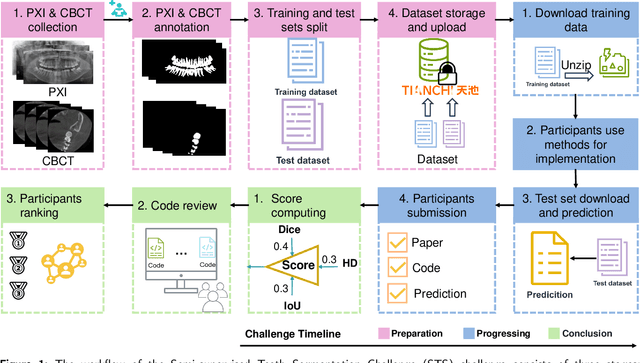


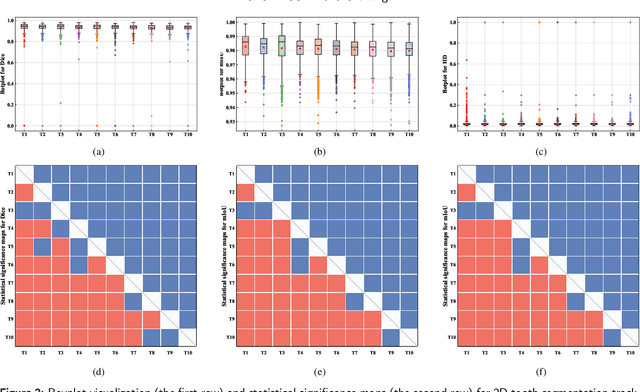
Abstract:Computer-aided design (CAD) tools are increasingly popular in modern dental practice, particularly for treatment planning or comprehensive prognosis evaluation. In particular, the 2D panoramic X-ray image efficiently detects invisible caries, impacted teeth and supernumerary teeth in children, while the 3D dental cone beam computed tomography (CBCT) is widely used in orthodontics and endodontics due to its low radiation dose. However, there is no open-access 2D public dataset for children's teeth and no open 3D dental CBCT dataset, which limits the development of automatic algorithms for segmenting teeth and analyzing diseases. The Semi-supervised Teeth Segmentation (STS) Challenge, a pioneering event in tooth segmentation, was held as a part of the MICCAI 2023 ToothFairy Workshop on the Alibaba Tianchi platform. This challenge aims to investigate effective semi-supervised tooth segmentation algorithms to advance the field of dentistry. In this challenge, we provide two modalities including the 2D panoramic X-ray images and the 3D CBCT tooth volumes. In Task 1, the goal was to segment tooth regions in panoramic X-ray images of both adult and pediatric teeth. Task 2 involved segmenting tooth sections using CBCT volumes. Limited labelled images with mostly unlabelled ones were provided in this challenge prompt using semi-supervised algorithms for training. In the preliminary round, the challenge received registration and result submission by 434 teams, with 64 advancing to the final round. This paper summarizes the diverse methods employed by the top-ranking teams in the STS MICCAI 2023 Challenge.
A Multi-Stage Framework for 3D Individual Tooth Segmentation in Dental CBCT
Jul 15, 2024Abstract:Cone beam computed tomography (CBCT) is a common way of diagnosing dental related diseases. Accurate segmentation of 3D tooth is of importance for the treatment. Although deep learning based methods have achieved convincing results in medical image processing, they need a large of annotated data for network training, making it very time-consuming in data collection and annotation. Besides, domain shift widely existing in the distribution of data acquired by different devices impacts severely the model generalization. To resolve the problem, we propose a multi-stage framework for 3D tooth segmentation in dental CBCT, which achieves the third place in the "Semi-supervised Teeth Segmentation" 3D (STS-3D) challenge. The experiments on validation set compared with other semi-supervised segmentation methods further indicate the validity of our approach.
CrossMatch: Enhance Semi-Supervised Medical Image Segmentation with Perturbation Strategies and Knowledge Distillation
May 01, 2024Abstract:Semi-supervised learning for medical image segmentation presents a unique challenge of efficiently using limited labeled data while leveraging abundant unlabeled data. Despite advancements, existing methods often do not fully exploit the potential of the unlabeled data for enhancing model robustness and accuracy. In this paper, we introduce CrossMatch, a novel framework that integrates knowledge distillation with dual perturbation strategies-image-level and feature-level-to improve the model's learning from both labeled and unlabeled data. CrossMatch employs multiple encoders and decoders to generate diverse data streams, which undergo self-knowledge distillation to enhance consistency and reliability of predictions across varied perturbations. Our method significantly surpasses other state-of-the-art techniques in standard benchmarks by effectively minimizing the gap between training on labeled and unlabeled data and improving edge accuracy and generalization in medical image segmentation. The efficacy of CrossMatch is demonstrated through extensive experimental validations, showing remarkable performance improvements without increasing computational costs. Code for this implementation is made available at https://github.com/AiEson/CrossMatch.git.
 Add to Chrome
Add to Chrome Add to Firefox
Add to Firefox Add to Edge
Add to Edge